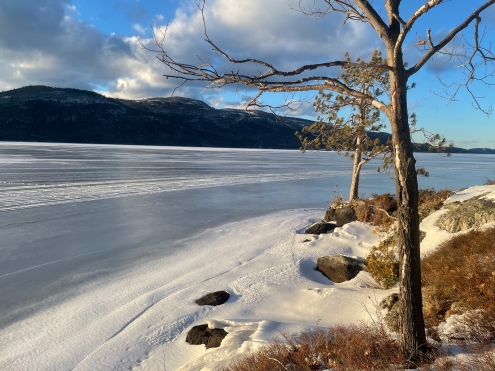
The Lake George Land Conservancy recently protected 150 acres in Bolton that includes a mile of steam that flows into Indian Brook, a major Lake George tributary.
The Lake George Land Conservancy (LGLC) has protected 150 acres of Bolton uplands through the use of a conservation easement, a tool used by land trusts that keep land in private ownership while protecting the land’s conservation values. The property includes one mile of stream corridor and 10 acres of wetland within the Indian Brook tributary of Lake George.
The property is owned by the DePace family, who sold the easement to the LGLC out of a desire to ensure its protection for future generations. Originally, the 150-acre tract was split into 23 residential lots, and allowed for 23 homes to be built. The DePace family and the LGLC worked to extinguish those 23 lots into just three lots. By doing so, important natural resources and the rural character of this region of Bolton are protected forever.
Landowners Tony and Gail DePace said, “Knowing that large parcels of Bolton Landing will be protected and environmentally healthy for many years to come is what prompted us to work together with the LGLC. Protecting the lands means protecting Lake George. The LGLC took every step to ensure that our personal needs and Bolton Landing’s environmental needs were met. The LGLC team worked extremely hard to put everything in place, no easy task after three years of getting every detail in order. We are fortunate to have the LGLC working diligently to protect Lake George and the lands surrounding it. Their mission is truly to protect the beauty we are fortunate to call home.”
Studies indicate that although Indian Brook is showing some impacts from development and other human activity, its watershed is still below the threshold of containing less than 10% of impervious surface, which is an indicator of overall health. Much of the watershed’s sensitive land is currently unprotected, however, leaving water quality vulnerable.
To address this issue, in 2017 the LGLC established its Indian Brook/Northwest Bay Conservation Initiative to work with willing landowners within the project area to acquire land and conservation easements that are vital to protecting water quality and important habitat, creating recreational opportunities, and keeping viewsheds intact.
LGLC Interim Executive Director Jeff Brozyna said, “This project perfectly demonstrates how the LGLC can protect land while also allowing it to remain in private hands. Conservation easements are a great way to protect sensitive lands while ensuring that landowners can continue to use and develop their land in sustainable ways. This project has so many obvious conservation values and it is wonderful to see the land protected—forever—after working on this project for a number of years. We are so grateful to the DePace family for their patience and their conservation ethic.”












